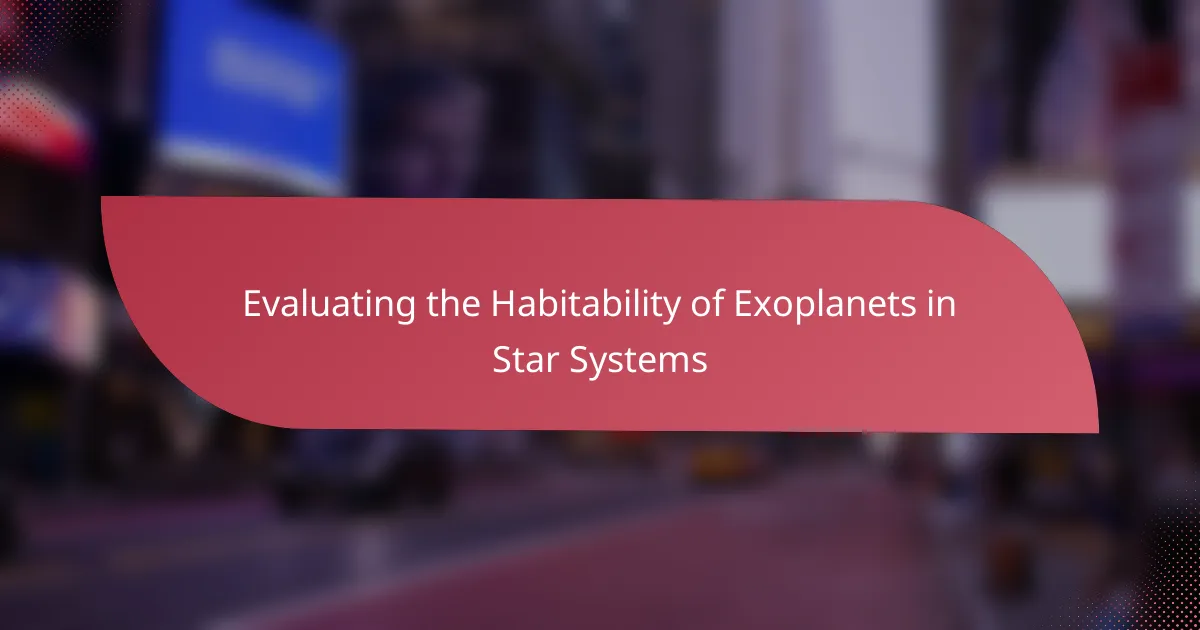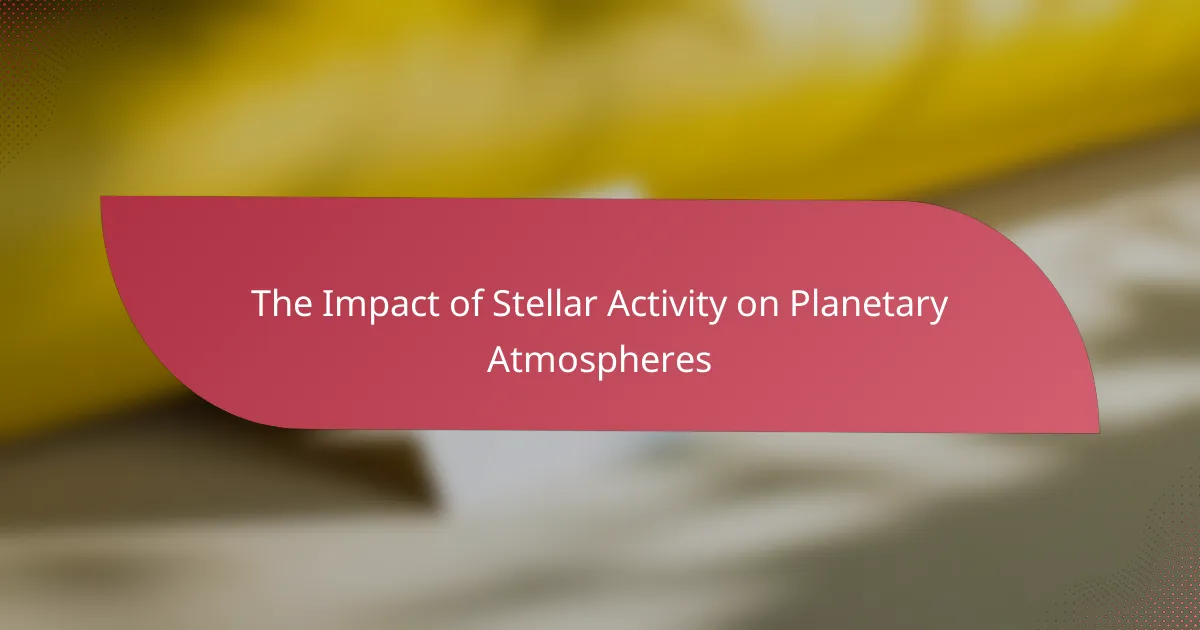Evaluating the habitability of exoplanets is a complex process that considers various factors essential for supporting life. Critical elements include a planet’s position within the habitable zone, its atmospheric makeup, surface conditions, and the availability of water, all while accounting for the influence of stellar radiation. Advanced tools are employed to analyze these distant worlds, helping astronomers identify promising candidates like Proxima Centauri b and TRAPPIST-1e.

How can we assess exoplanet habitability?
Assessing exoplanet habitability involves evaluating various factors that contribute to a planet’s potential to support life. Key aspects include its location in the habitable zone, atmospheric composition, surface conditions, presence of water, and the effects of stellar radiation.
Using the Habitable Zone concept
The habitable zone (HZ) is the region around a star where conditions may be right for liquid water to exist on a planet’s surface. This zone varies depending on the star’s size and temperature, typically ranging from a few million kilometers to several billion kilometers from the star.
To determine if an exoplanet lies within the HZ, astronomers calculate its distance from the star and consider the star’s luminosity. For example, a planet orbiting a cooler star may need to be closer to be habitable compared to one orbiting a hotter star.
Analyzing atmospheric composition
The composition of an exoplanet’s atmosphere is crucial for habitability, as it affects temperature regulation and potential for life. Key gases to look for include oxygen, carbon dioxide, and methane, which can indicate biological processes.
Using spectroscopy, scientists can analyze light from a planet’s atmosphere during transits. This method allows them to identify the presence of these gases and assess whether the atmosphere can support life as we know it.
Evaluating surface conditions
Surface conditions, including temperature, pressure, and geological activity, play a significant role in determining habitability. A stable climate with moderate temperatures is generally more conducive to life.
In addition, the presence of geological features, such as mountains and valleys, can indicate past or present water activity, which is essential for life. Models can simulate surface conditions based on the planet’s distance from its star and atmospheric composition.
Considering water presence
Water is a fundamental requirement for life, making its presence a critical factor in assessing habitability. Scientists look for signs of liquid water, such as lakes or oceans, as well as water vapor in the atmosphere.
Research has shown that even small amounts of water can significantly increase a planet’s potential for supporting life. Therefore, identifying water sources is a priority in the evaluation process.
Studying stellar radiation
The type and amount of radiation emitted by a star can greatly influence an exoplanet’s habitability. High levels of radiation can strip away atmospheres and create harsh conditions that are not conducive to life.
Understanding the stellar environment involves analyzing the star’s activity, including solar flares and ultraviolet radiation. This information helps scientists predict whether a planet can maintain a stable atmosphere and support life over time.

What tools are available for exoplanet evaluation?
Several advanced tools are utilized for evaluating exoplanets, each offering unique capabilities for detecting and analyzing these distant worlds. These tools help astronomers assess the habitability potential of exoplanets by examining their atmospheres, orbits, and other critical factors.
Kepler Space Telescope
The Kepler Space Telescope was launched to discover Earth-sized exoplanets in the habitable zones of their stars. It used the transit method, monitoring the brightness of stars and detecting periodic dips caused by planets passing in front of them.
Over its mission, Kepler identified thousands of exoplanets, providing valuable data on their sizes and distances from their host stars. This information is crucial for determining whether these planets could support liquid water, a key ingredient for life.
TESS (Transiting Exoplanet Survey Satellite)
TESS is designed to survey a larger area of the sky than Kepler, focusing on nearby stars to find transiting exoplanets. Its mission aims to identify planets that can be studied in greater detail by other telescopes.
By targeting bright stars, TESS increases the chances of finding potentially habitable exoplanets that are easier to observe with follow-up instruments. This approach allows astronomers to prioritize their research on the most promising candidates.
James Webb Space Telescope
The James Webb Space Telescope (JWST) is set to revolutionize exoplanet evaluation with its advanced infrared capabilities. It can analyze the atmospheres of exoplanets by observing the light that filters through them during transits.
JWST will enable scientists to detect chemical signatures, such as water vapor and carbon dioxide, which are essential for assessing habitability. Its sensitivity to faint signals makes it a powerful tool for studying distant worlds.
Spectroscopy instruments
Spectroscopy instruments play a critical role in analyzing the composition of exoplanet atmospheres. By measuring the light spectrum from a star and its planets, these instruments can identify specific molecules present in the atmosphere.
Commonly used spectroscopy techniques include transmission spectroscopy and emission spectroscopy, each providing insights into the chemical makeup and potential habitability of exoplanets. Understanding atmospheric composition is vital for evaluating whether conditions might support life.

Which exoplanets are currently considered habitable?
Currently, several exoplanets are deemed potentially habitable based on their location in the habitable zone of their stars, where conditions may allow for liquid water. Key candidates include Proxima Centauri b, TRAPPIST-1e, Kepler-186f, and LHS 1140 b.
Proxima Centauri b
Proxima Centauri b orbits the closest star to our solar system, Proxima Centauri, located about 4.2 light-years away. This exoplanet lies within its star’s habitable zone, where temperatures could permit liquid water to exist.
However, Proxima Centauri b is subject to stellar flares from its host star, which may affect its atmosphere and potential for habitability. Ongoing studies aim to assess its atmospheric conditions and the implications for life.
TRAPPIST-1e
TRAPPIST-1e is one of seven Earth-sized planets orbiting the ultracool dwarf star TRAPPIST-1, approximately 40 light-years from Earth. It is located in the star’s habitable zone, making it a prime candidate for the search for extraterrestrial life.
This exoplanet may have a rocky surface and could support liquid water, but its actual habitability depends on various factors, including atmospheric composition and radiation levels from its star.
Kepler-186f
Kepler-186f is notable for being the first Earth-sized exoplanet discovered in the habitable zone of another star, located about 500 light-years away. It orbits a star that is cooler and smaller than our Sun, which influences its potential habitability.
With a size similar to Earth, Kepler-186f is believed to have the right conditions for liquid water, but further research is needed to understand its atmosphere and surface conditions.
LHS 1140 b
LHS 1140 b is a super-Earth located about 40 light-years away, orbiting a red dwarf star. It is situated in the habitable zone and has a mass that suggests it could retain a substantial atmosphere.
The planet’s proximity to Earth makes it an excellent candidate for further study, particularly regarding its potential for hosting life and the characteristics of its atmosphere.

What are the criteria for determining habitability?
Determining the habitability of exoplanets involves several key criteria that assess whether a planet can support life. These criteria include temperature range, atmospheric pressure, and the presence of a magnetic field, each playing a crucial role in creating a stable environment for life as we know it.
Temperature range
The temperature range of an exoplanet is vital for habitability, as it influences the state of water, a critical component for life. Generally, a temperature range of about -20°C to 50°C is considered suitable for liquid water to exist, which is essential for biological processes.
When evaluating temperature, consider the planet’s distance from its star and the star’s type. For instance, planets in the habitable zone of a sun-like star are more likely to maintain temperatures conducive to life. However, extreme temperatures outside this range can lead to frozen or vaporized conditions, making life unlikely.
Atmospheric pressure
Atmospheric pressure affects the boiling point of water and the retention of gases necessary for life. A pressure range similar to Earth’s, approximately 1 to 2 atmospheres, is generally favorable for sustaining liquid water and a stable climate.
Too low a pressure can lead to water vaporizing, while too high pressure can create extreme conditions that may be inhospitable. Understanding the composition of the atmosphere is also critical, as it must contain essential gases like oxygen and nitrogen in appropriate ratios to support life.
Magnetic field presence
The presence of a magnetic field is important for protecting a planet’s atmosphere from solar winds and cosmic radiation. A strong magnetic field can shield the atmosphere, preventing it from being stripped away, which is crucial for maintaining conditions suitable for life.
Planets like Earth benefit from a magnetic field generated by their molten core, which helps preserve their atmosphere and enables stable climatic conditions. In contrast, planets without a magnetic field may face harsher environments that could hinder the development or sustainability of life.



